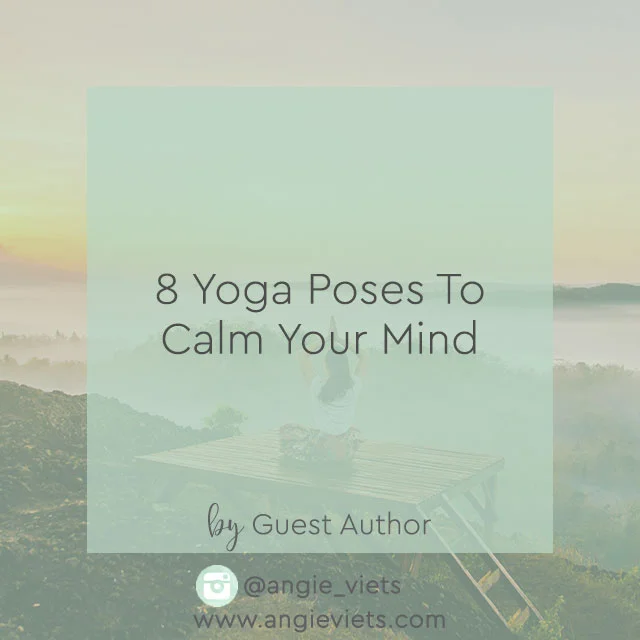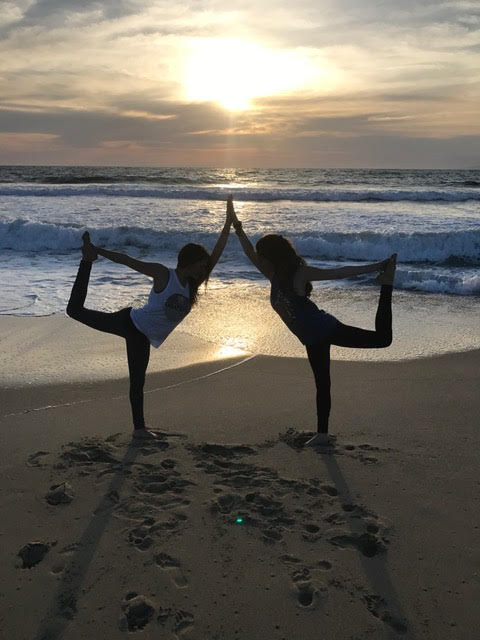Making Peace With Our Reflection in The Mirror
How Yoga Can Help You Return to Your Senses in Eating Disorder Recovery
Photo Credit: Marion Michele
I was 18, pulled from my sophomore year of college, and on my way to inpatient treatment for the first time. I sat in the backseat of the car, curled up in my mother’s arms, cold, weak, and desperately afraid.
I have one distinct memory from that ride to Philadelphia: driving past the old Nabisco factory, which, until it closed in 2015, had filled the entire neighborhood for decades with the smell of sugar cookies. As a child, that smell and the cookies the factory produced were mouthwatering. A source of pure joy. An innocent pleasure. That day the sweetness in the air was a cruel joke. I couldn't bear it. I rocked in panic, my throat closed, I moaned, cried, and buried my face as deep into my mother’s side as I possibly could.
That was the first time my sense of smell had been so intensely stimulated in a while, and it petrified me. Starvation had numbed me and compromised my senses. The fear of smells and tastes were paralyzing. My vision was blurry, and I could only hear my eating disorder voice. All other sounds were muffled in the background.
It’s only through looking back on that memory 20 years later, that I understand how anorexia literally desensitized me. As we all know, our eating disorders serve a precise function: to protect. Along the descent into eating disorder hell, protection turns into destruction, leaving us isolated in the torment.
“We hollow out physically, emotionally, mentally, and spiritually. Sensation is unwelcome. Feeling is not the point.”
In my experience, the healing process from an eating disorder is a tumultuous effort of learning how to “sense” again—how to sense hunger cues, emotions, our bodies, our intuition, and how we feel in relationships. It’s also a return to our literal senses, sensations, and sensory experiences. In many ways, this aspect of healing—returning to our senses—is what resuscitates our souls by bringing color, textures, and richness back into our lives.
How do we go from numb to sensory human beings?
I find it to be an ongoing process that requires support, patience, and resilience. In my healing, yoga has helped me return to my senses in profound ways. For me, yoga is a safe place to learn how to feel and name sensations that happen in my body. In half pigeon pose I sense an intense stretch in my hip, in forward folds I feel discomfort in my hamstrings, and in triangle pose I notice the sensation of expansion. The more I have become comfortable identifying, naming, and sitting with physical sensations that arise in my body, the easier and more natural it becomes to name and feel emotions, even the painful ones.
The practice of naming physical sensations can be applied to other activities as well. My advice is to find an activity that you enjoy and take stock every so often of what you feel and where you feel it. Name the sensation. Become familiar with it. Observe it. This skill will become useful for naming emotions and experiencing them versus turning to symptoms to banish them.
I recognize that naming sensations in our bodies can aggravate or cause turmoil around body image. Even so, healing requires we name those feelings too. Part of regaining our senses is also knowing and defining our limits. Trust your instincts around when and how often to practice identifying sensations.
“Like all aspects of healing, returning to our senses is also a process.”
Yoga has also helped me develop my sense of sight. Before I used to stare down food like I would an enemy. Or I'd avert my eyes, turn away from what was fearful. In yoga, we often talk about keeping the eyes soft to embody a sense of ease and calm. I’ve noticed that when my eyes are soft (meaning I am not scrunching up my forehead to fiercely concentrate), my thoughts are kinder. I judge, berate, and demand less. I am more open to the sensory experience of the pose and less concerned about controlling the outcome.
Applying soft eyes in difficult life moments has often made the difference between making a positive choice versus an unhealthy one. Soft eyes have also helped me to stand in front of the mirror and see myself from all angles with compassion.
On a final note, as I recall the Nabisco factory and the difficulty it caused me that day, I can’t help but smile when I imagine how happy the smell would make my two little girls, how much it would light them up, and how they would beg me to stop for cookies. Children have the most beautiful relationship with their senses; automatic, curious, simple, and joyful. Little ones represent the model of what’s possible for all things good. They remind me how much more fun sensational is than numb.
Jennifer Kreatsoulas, PhD, RYT 500 is the founder of Chime Yoga Therapy and specializes in eating disorders and body image. In addition to her private yoga therapy practice, Jennifer leads yoga therapy groups at the Monte Nido Eating Disorder Center of Philadelphia, is cofounder of the Body Kindness Project, and a partner with both the Yoga and Body Image Coalition and the Transformation Yoga Project. She is the creator of the home video series Yoga to Strengthen Body Image and Support Eating Disorder Recovery. Her writing on the topics of yoga, body image, motherhood, and eating disorder recovery can be found on her blog as well as several influential online publications. Connect with Jennifer.
5 Reasons Why Yoga is So Good For Your Mind and Body
Photo Credit: Body Love, Soul Purpose
1. As a discipline for the body and mind, yoga helps you cultivate vibrant health. Yoga is a superb form of balanced exercise and offers a potent source of calm in our stress-filled lives.
2. Yoga is a powerful mind/body system that has helped countless people achieve inner peace and fulfillment. Yoga helps you reconnect with yourself from the inside out by working with your body and breath, your mind and emotions.
3. Yoga allows you to release body-stored memories, fears, and traumas that trap you in the past. Yoga helps you to achieve emotional balance, live in the present moment, and begin to feel joy (again).
4. The wisdom of yoga helps you to navigate the ups and downs of everyday living. Yoga helps you to lovingly explore your self-doubt and struggles, welcoming time and again, the life that you have, imperfections and all.
5. Yoga can lead you to accept your body, uncover your particular gifts, discover your own true self, and cultivate a more satisfying life in the world.
If you’re interested in learning more about how yoga can play a part in your recovery, and/or would like to participate in a Women’s Fall Retreat that will incorporate all of the recovery-focused benefits of yoga above, click here for more information.
Rachel Daggett, MS, MFTI is a Wellness and Recovery Coach and a Registered Therapist Intern. She has a private practice in Manhattan Beach, CA, and strives to be an active force of empowerment and love in the community. Through struggling with her own eating disorder and journey of healing, and now being recovered, she has become an advocate for eating disorder recovery and mental health. Rachel has a Masters degree in Psychology, and believes in the importance of caring for the mind, body, heart, and soul as a whole. Rachel is a yogi, a dog-mom, a beach-girl at heart, and has recently started studying the natural healing power of essential oils. Visit her website.
3 Yoga-Inspired Ways To Deal With Triggering People, Places & Things
We all have people in our lives who challenge our patience and test our resolve. No matter how kindly you have asked them to not discuss certain topics or refrain from making certain comments, these individuals don't ever seem to get the message. Or, it's the case of being at work or a social event and having no choice but to endure triggering conversations.
It's the worst, right?
I've been there. Like the time someone brought me chocolate covered pretzels as a gift while in inpatient treatment for an eating disorder! For REAL! Oh, I could go on and on. And I am sure you could, too.
But here's the thing about "going on and on:" we get charged up, aggravated, and thrown off our center. Our minds spin with negativity as we relive, ruminate, and rehearse the past. This is not to say we should not feel what we need to feel to heal. We must do that important work too. But we must also learn how to remain present and peaceful to protect ourselves from the side effects of triggering people, places, and things.
My yoga practice has taught me some very helpful skills for dealing with triggering people, settings, and conversations. These yoga-inspired approaches are challenging because they ask us to be kind when we are provoked, grounded when we are revved up, and calm when we are flustered. Yet, they are also extremely freeing, because we learn we can choose to not make someone's ignorance or insensitivity about us ("It's not me, it's you" is what I mean here.)
Here are 3 yogic ways that I use to stay present and peaceful when I am in a triggering situation. I want to share what I've learned and what helps me with the sincere hope that they help you as well.
No. 1: Stay neutral
Yoga philosophy teaches that the more neutral we can remain in our lives, the less we will suffer. For example, think of a yoga pose that physically challenges you. Visualize yourself in the pose. Now notice: What's your attitude in the pose? Are you holding your breath or breathing with ease? Are you counting down for the pose to be over or are you able to rest your mind on your breath and be calm? Are you miserable or unaffected and open to what is? When we hold a sense of calm in a pose, our physical, emotional and mental dispositions are more toward neutral than when we are panting and impatient.
This same idea applies off the mat, too. When we are reactive to a person, place, or thing, we tend to be the opposite of neutral. To be neutral does not suggest we should not care. Instead, neutral means not being over or underwhelmed with emotion. We sort of settle into the moment and "just be." When you sense yourself getting worked up and you feel stress settle in your body (perhaps in your neck or shoulders or arms) and your mind starts to spin, that's the time to shift from distress to a more neutral zone. To do this, purposefully relax tense areas of your body and repeat "I am neutral" or just simply "neutral" to yourself over and over until you sense yourself calming down. You might also firmly ground your feet into the floor or your hands into one another and take a few deep breaths to help create neutrality in your body.
No. 2: Exhale often and with gusto
Deep breathing is great, magical even when dealing with stress. But sometimes we need to let off some steam. To do that peacefully, let out a good, strong sigh. Exhale like you mean it. I sigh ALL the time. Even when I am feeling happy. Sighing is an easy way to release, reconnect with self, and clean out stagnant thoughts and emotions, like frustration and irritation.
No. 3: Wish others well
I have found the yogic path of love--also called bhakti yoga--to be a helpful practice when I am with challenging people. This yogic path focuses on the emotional nature of relationships with ourselves and others, and it teaches about how to balance strong emotional states—such as sadness, fear, worry, anxiety and so forth. To smooth out these dips in mood, or become more neutral, one way you can practice bhakti yoga is by simply wishing others well. It is a simple practice, and the intention behind it is virtuous. I am not suggesting you say these words (I wish you well) directly to the people who are driving you crazy. Rather, this is a quiet practice meant only for you to hear. It cultivates positivity within and extends goodness without. Praying for others creates the same energetic goodness. When you feel triggered, try pausing to send out goodness to the person who is instigating you. Simply say in your mind, "I wish you well." Repeat this mantra to yourself until you feel less agitated and more good will within. Doing so will calm your nervous system and balance out stress-producing emotions.
These yogic approaches will not change a blessed thing about the person or situation that is causing you angst. Instead, they will strengthen your relationship with yourself, because you will feel empowered to peacefully handle triggering moments. When we build and nurture that kind of trust with ourselves, we learn how to lead our lives rather than ping pong between people, places and things that we feel we have to guard against. We ultimately learn to wish ourselves well
Jennifer Kreatsoulas, PhD, RYT 500 is a yoga teacher and yoga therapist specializing in eating disorders and body image. In recovery herself, Jennifer is extremely passionate about helping others reconnect with their bodies and be empowered in their lives. She also teaches yoga at the Monte Nido Eating Disorder Center of Philadelphia and is a partner with the Yoga and Body Image Coalition. She leads trauma-sensitive yoga classes and teaches weekly flow yoga classes. Jennifer contributes regularly to several eating disorder and body image blogs and the YogaLiving Magazine. Connect with Jennifer.
Shut Down ED Rituals With This Simple Yoga Practice
What was your very first thought when you woke up this morning? Did you feel ready to embrace the day or were you sucked into a spiral of worrisome thoughts about food and your body? How much time and energy did you expend enacting a line up of rituals to control the outcome (or intake) of the day ahead?


































